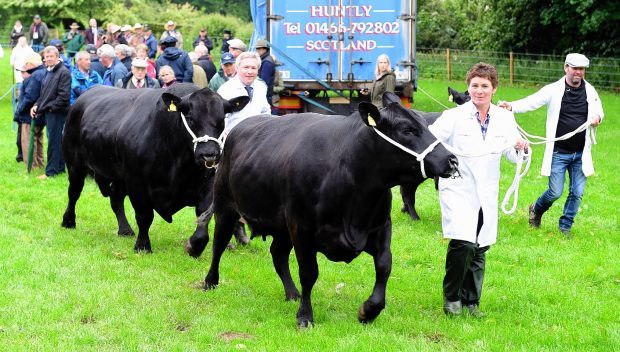The work of William McCombie of Tillyfour, Alford, has long been recognised as a key to the Aberdeen-Angus breed’s history and the Forum’s visit to Tillyfour brought part of the breed’s heritage alive with a dramatisation of Queen Victoria’s visit to the Donside farm in 1863.
The event where McCombie paraded his prize-winning stock around the house at Tillyfour for Her Majesty was re-enacted with Mary Gash playing the Queen and an indirect descendant, Charles McCombie, playing the great man himself. Several local breeders paraded their stock for the “royal” and international gathering including some from the countries of Queen Victoria’s empire. It was held in a field behind Tillyfour House with the new wing constructed by McCombie for the Queen’s overnight stay very much in view.
For those with an interest in Aberdeen-Angus cattle, McCombie is regarded as royalty. Born at Tillyfour in 1805, his father Charles and his grandfather were both in the cattle trade. At that time much of this trade meant driving lean cattle out of Aberdeenshire to the trysts in central Scotland for selling to English dealers.
Indeed Charles McCombie is recorded as having sold 1,500 beasts at the Michaelmas tryst at Falkirk and his shrewd bargaining allowed him to purchase Tillyfour.
Charles did not want his sons to enter the tough cattle trade where fortunes could be won and lost and lives could be lost too on the dangerous drove routes. His eldest son, also named Charles, went into the ministry and served the parish of Lumphanan for 30 years. For William however it was to be cattle he turned to after leaving university education early. He learned farming and the lean cattle trade from his father and knew what to look for in animals to turn a profit.
Both favoured the local black polled cattle, the Buchan Hummlies, and in future years William would use this type in his breeding exploits. He leased Tillyfour from his father in 1824 and subsequently his elder brother and began his career in his own right. Not long after, he started to breed his type of cattle which were needed for the changing face of the cattle trade.
By now the importance of turnips was being discovered as a cleaning crop but more importantly as winter feed allowing animals to be kept through the winter and be fattened rather than driven south for fattening in England. With steam transport at sea and later on rail, beef could be transported quickly in mass to mass markets.
McCombie saw the potential of breeding for beef and waved goodbye to the droving trade. His eye for cattle and for profit meant that he was determined in the type he was breeding for.
He used local black polled cattle with some bought at St John’s Wells and Wester Fintray. However it was his purchase of black polled cattle known as Doddies from that great Angus breeder Hugh Watson of Keillor at Newtyle, known as the founder of the breed, that really set McCombie off as the builder of the breed. He also bought others from the likes of Fullerton of Ardovie, Lord Panmure of Brechin Castle and Bowie of Mains of Kelly at Arbroath.
At this time the black cattle could have easily been eclipsed and never have made it to a recognised breed.
Aberdeenshire was well known as the area where the Shorthorn breed was developed into a beef type separating it from the differing dairy types. Men like Amos Cruickshank of Sittyton, Hay of Shethin and later Campbell of Kinellar all staked a claim for this breed in the area.
McCombie’s skill as a great breeder and also as great showman saw him take major honours at Birmingham, Smithfield and of course Paris in 1862. This all helped put the blacks in pole position. Remarkably he was also to become the Liberal MP for West Aberdeenshire becoming the first tenant farmer to sit in the House of Commons in 1868.










